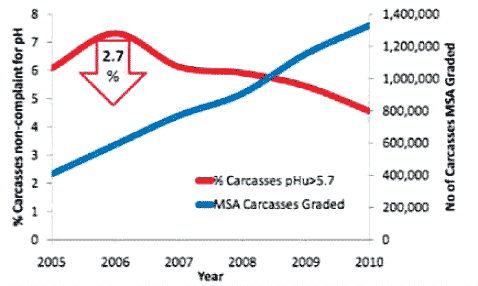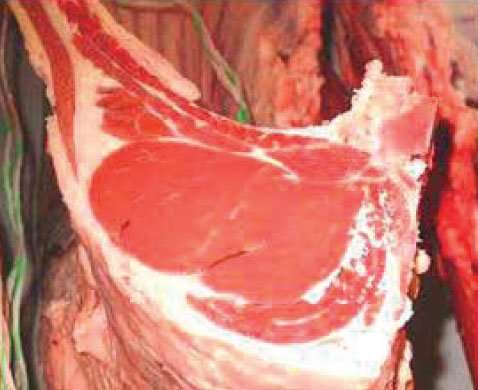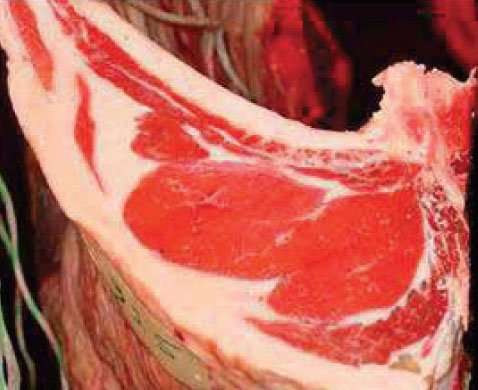New Beef CRC-funded research conducted by Murdoch University has shown that increased muscularity is a factor associated with lower ultimate carcass pH, leading to a reduced incidence of dark cutting.
In 2009, dark cutting cost the Australian beef industry around $35 million.
“Dark cutting meat is dry to taste, spoils very quickly, has variable tenderness and is very dark in colour,” explains Peter McGilchrist, who conducted the research with his colleagues at Murdoch.
If there is low glycogen in the muscle, the pH remains elevated and the meat will be dark.
Based on Meat Standards Australia, when a carcass ultimate pH exceeds 5.7 dark cutting is triggered.
For a steak to be a desirable bright cherry-red colour, the pH of the meat must drop from a pH of 7 at slaughter down to an ultimate pH of less than 5.7 in the 24 hours after slaughter.
Meat from carcasses with an ultimate pH in the loin higher than 5.7 have darker meat colour, shorter shelf life, bland flavour, variable tenderness and resist cooking, which impacts on degree of doneness.
In 2009, Meat Standards Australia graded over one million cattle with 5.45% having a pH greater than 5.7 (see Figure 1). Due to its effect on quality, beef producers are commonly penalised up to $0.50 per kg carcass weight for carcasses with a pH greater than 5.7.
In carcasses less than 350kg, the effect of increased EMA from 40 to 80cm2 reduced the proportion of noncompliant carcasses with an ultimate pH above 5.7 from around 22% to 6%.
Relationship between muscling and Dark Cutting
The Murdoch research team found animals with higher muscle content, as defined by size of carcass eye muscle area (EMA) adjusted for hot standard carcass weight, is strongly associated with reduced incidence of dark cutting (Figure 2).
Figure 1: Percentage of carcasses non-compliant for pH (left hand side) and number of carcasses MSA graded across Australia (right hand side)

In carcasses over 350kg the non-compliance level dropped from around 8% to 3% as EMA increased from 50 to 80cm2.
The current average EMA from all MSA data across Australia is 64cm2.
Producers should aim to produce animals that have an EMA greater than 70cm2 for a 250kg carcass.
“If muscling is increased to slightly above average, to around 70 or 75cm2, this should greatly minimise the risk of dark cutting,” says Mr McGilchrist.
To achieve this, producers should utilise sires with an Estimated Breeding Value (EBV) for EMA higher than the average. Producers can evaluate their current position by viewing MSA feedback sheets which give EMA measurements, thus allowing appropriate breeding and management decisions to be made.
Muscling and Insulin and Adrenaline Sensitivity
Overall, muscle glycogen at slaughter is a function of initial muscle glycogen ‘on-farm’, minus the quantity of glycogen loss due to stressors during the pre-slaughter period.
Animals with low initial glycogen concentrations that undergo similar pre-slaughter stress are more susceptible to dark cutting.
In a separate study, Mr McGilchrist found that heavier muscled animals had increased insulin sensitivity and decreased adrenaline sensitivity.
This indicates that more muscular cattle have increased glycogen synthesis after eating and reduced glycogen breakdown during stress.
Both of these conditions result in increased muscle glycogen at slaughter, increasing the likelihood of having sufficient muscle glycogen for the carcass to reach an ultimate pH below 5.7.
Importance of Muscling
A reduction in the incidence of dark cutting in high muscled cattle complements the other advantages of muscular cattle, such as increased retail beef yield and processing efficiency.
The relationship between increased muscling and reduced dark cutting is a very important finding for the beef industry, as it demonstrates that beef producers can actively select for more muscular cattle knowing it will help to reduce the incidence of dark cutting carcasses in their herd.
This article is based on a paper presented at the 57th International Congress of Meat Science and Technology, Ghent, Belgium.
What causes Dark Cutting?
Dark cutting is associated with insufficient muscle glycogen reserves in the muscle at the time of slaughter. The amount of glycogen present in the muscle before slaughter determines how much lactic acid the muscle is able to produce. If there is insufficient muscle glycogen at time of slaughter, the carcass pH ecline will not be sufficient to reach an ultimate pH of below 5.7. If there is low glycogen in the muscle, the pH remains elevated and the meat is dark.
LargeEMA

SmallEMA

Figure 2: Higher muscle content is defined by the size of carcass eye muscle area (EMA). Increased muscularity is associated with lower ultimate carcass pH, leading to a reduced incidence of dark cutting.
Fast Facts
- Animals with larger Eye Muscle Area (EMA) at a given carcass weight have a reduced incidence of dark cutting
- Aim to produce animals with an EMA greater than 70 cm2 for 250kg carcass weight
- Producers can evaluate their current EMA position by viewing MSA feedback sheets which give EMA measurements, thus allowing appropriate breeding and management decisions to be made
BY CRC BEEF – BEEF BULLETIN DECEMBER 2011
BRAHMAN NEWS MARCH 2012 ISSUE #174

